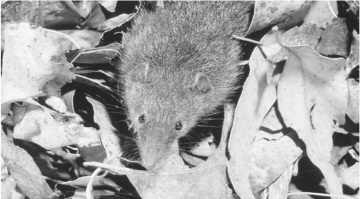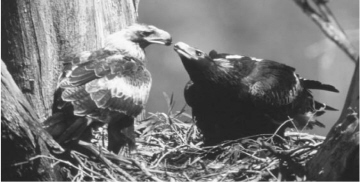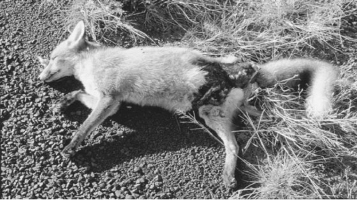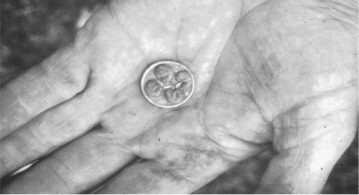Tasmanian Devil (9 page)

This photograph offers rare proof of the predatory ability of the spotted-tailed quoll.
This one has chased down and is killing a pademelon. (Courtesy Michael Good)
As the Australian continent dried out and heated up, the paucity of grazing or browsing vegetation shrank not only the megafauna but their replacements as well. Yet in this respect the Tasmanian devil is a veritable giant. Quolls aside, an adult male devil is up to 150 times larger than its closest marsupial relatives. They're also completely unalike, an indication of how varied the evolution of Australia's marsupial carnivores has been.
Thus the swamp antechinus (
Antechinus minimus
, âsmallest hedgehog equivalent') distributed across Tasmania and coastal Victoria, weighs about 65 grams. A strictly nocturnal insect eater and ground dwellerâunlike the even smaller brown antechinus (
A. stuartii
) which likes to live in treesâthis tiny marsupial is described as the smallest of the quolls. A unique feature of the antechinuses is semalparousness, the death of the male after sex. (It is also a feature of the life cycles of squid and flying ants.)

A male dusky antechinus in its favourite habitat of forest leaf litter. The tiny
antechinus, weighing just 65 grams, is closely related to the Tasmanian devil. Males
die within three weeks of mating, a feature of young devils since the onset of DFTD.
(Courtesy W.E. Brown)
The little red antechinus (
Antechinus rosamondae
), which weighs about 40 grams and preys vigorously on lizards, seems to owe its precarious existence along the mid-north coast of Western Australia to the fire-resistant, inedible woolly spinifex in which it lives.
The kowari (
Dasyuroides byrnei
) of central Australia, one of a number of marsupial species that become torpid during cold weather, is also a fierce hunter and vocally aggressive:
A variety of sounds are produced, including an open-mouthed hissing and a loud, staccato chattering, both made in response to threats from predators or other kowaris . . . Vigorous tail-switching, reminiscent of an angry cat, is used as a threat display.
18
The red-tailed phascogale (
Phascogale calura
) survives in Australia's arid centre through an impressive adaptation: it is immune to the poisonous plants upon which it feeds, as are the native carnivores which prey upon it. But the poison fluoroacetate, found in the Australian legumes
Gastrolobium
spp. and
Oxylobium
spp., kills introduced species.
An unusual adaptation is that of the long-tailed planigale (
Planigale ingrami
), one of the world's smallest mammals (the average male adult weighs 4.2 grams). Its head is flattened so that it can enter cracks and narrow spaces in search of the insects, lizards and small mammals which it attacks with ferocity.
A species as endangered as the spotted-tailed quoll, and matching the devil for size, now has full claim on being Tasmania's top order predator. The wedge-tailed eagle is a supreme hunter, one of the world's largest eagles. This majestic raptor, although distributed across Australia and New Guinea, is listed as vulnerable in Tasmania (subspecies
Aquila audax fleayi
). Its diet is a practical one, relying generally on possums, wallabies, rabbits, hares, birds and carrion. This means that wedge-tailed eagles and devils are direct competitors.
The eagle, like the thylacine, has long been demonised as a lamb-killer and has endured heavy persecution. Indeed, the formation in 1884 of the Buckland and Spring Bay Tiger and Eagle Extermination Society set in motion the Tasmanian parliamentary debates that were to signal the extermination thylacine. Well over a century later the âwedgie' continues to be persecuted, with some rural Tasmanians taking a gun to it when they can.

The wedge-tailed eagle, one of the world's largest birds of prey, is considered to be
Tasmania's top order predator now that the thylacine is extinct. Human alteration
to the land, as well as direct persecution, have adversely affected both species for over
two hundred years. The parent bird is on the right. (Courtesy W.E. Brown)

If the European red fox becomes established in Tasmania, as it is on mainland
Australia as an introduced species, it will compete directly with the devilâfor prey,
for dens and as a predator of devil young. In combination with DFTD, the fox may
unwittingly hasten the Tasmanian devil's extinction. (Courtesy W.E. Brown)
Finally, there is the European red fox, long established on the mainland as an introduced species and potentially becoming established in Tasmania. Just as the devil may have inadvertently hastened the end of the thylacine, an ineradicable fox population may do the same to a heavily decreased devil population. But should this eventuate, the highly competitive, efficient fox should not be made the scapegoat for having been introduced to Tasmania.

âMADE FOR TRAVELLING
ROUGH': DEVIL ECOLOGY
Little Devil only wanted milk for several days given by a bottle while being cradled in my arms and loved being cuddled and would emit the most piercing sound when he had finished feeding. Little Devil lived in an old meat safe near the pot belly stove during the day in the kitchen and at night would come out for his meat and biscuits, but should anyone other than myself be in the kitchen he would retreat until all was quiet . . . Eventually the kitchen door was left ajar so he could come in and out at night, this happened for some time before he decided he was old enough to make it on his own. I guess like all teenagers he grew up. It will always remain one of my most treasured memories.
D
ONNA
C
OLEMAN
, G
ORDON
I
n its evolutionary journey the Tasmanian devil has travelled remarkably well. And quickly: known devil fossils date back no more than 70 000 years and over that time the animal has undergone little change to its body plan other than dwarfism. Its physical and behavioural characteristics helped ensure its success as one of the seven extant large-size marsupial carnivores of Australia and New Guinea.
The squat, muscular body and short strong legs enable it to lope long hours in search of food and, in the case of males, reproductive partners. Because they are large, the head and neck have increased functional significance in feeding. The devil's profuse, wiry vibrissae (whiskers) grow in patches from the tip of the chin to the back of the jawline, and are long enough to extend beyond shoulder width, acting as sensors during night movement, feeding and communication.
Devils, like dogs, have 42 teeth. (Cats have just 30.) Devils keep their original teeth, which continue to grow very slowly throughout the lifetime of the animalsâthey are not replaced.
The long claws are designed to dig efficiently, for denning and in search of food, and to firmly grip prey to facilitate chewing and gnawing. The sense of smell is acute and can detect food up to a kilometre away.
This structural emphasis on feeding places the devil in the company of one of nature's iconic loners, the great white shark. A big old male devil has a shark-like forward torso, resulting in a great neck and head with a full but definite taper, providing immense power, out of proportion to the overall body.
The reproductive cycle of the devil is highly synchronised, but not inflexible. Female devils ovulate up to three times during the three-week breeding season, usually in late March, and copulation is almost continuous for up to five days at a time. The male goes to great lengths to keep other males away from his mating partner, keeping her prisoner in the copulation den with little chance to eat or drink. One thirsty male was observed dragging a female with him from a den to a water source and back to the den.
1
David Pemberton and the Mount William ranger Steve Cronin once monitored a male and female in an underground mating den in the wild. The animals hadn't moved from it for eight days and nights, so, wondering if they had died, Pemberton dug a narrow hole through to the burrow and put his arm down, holding a small mirror. His colleague shone a torch onto the mirror, which revealed a threatening set of bared devil teeth.
However, the intensity of male competition generally ensures that during a normal breeding season males breed with more than one female. Menna Jones' studies of breeding indicate that females can be selective, and this means that in combination with multiple sperm donors the female optimises her chances of delivering the best available genetic offspring.

At birth, Tasmanian devils are tiny, as shown by these four newborns on a coin.
(Courtesy Nick Mooney)
At birth a Tasmanian devil is no larger or heavier than a split pea. A prime four-year-old male is some 15 000 times heavier, at about 11 kilograms. (In comparison, from birth to maturity the average domestic cat increases in weight about 20-fold.) At six years the male will be dead, having sired perhaps sixteen offspring. An adult female, weighing about 7 kilograms, has on average four breeding seasons, producing about twelve offspring during her lifetime. The mating season is three weeks; pregnancy lasts just eighteen days; the young are dependent on their mother for at least nine months, which means the female then has little time to herself before the next mating season. This demanding cycle means devil populations can theoretically double in size each year, an excellent safeguard against high mortality in both juvenile and adult populations.